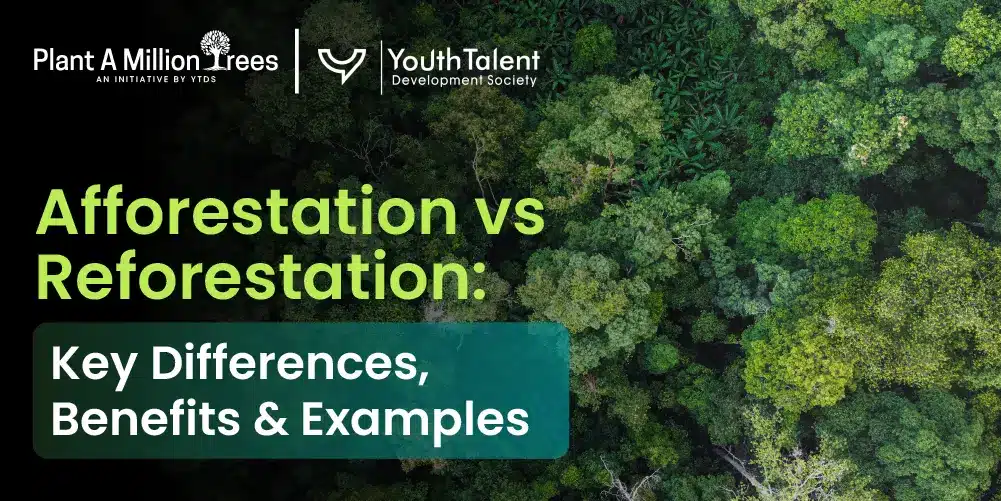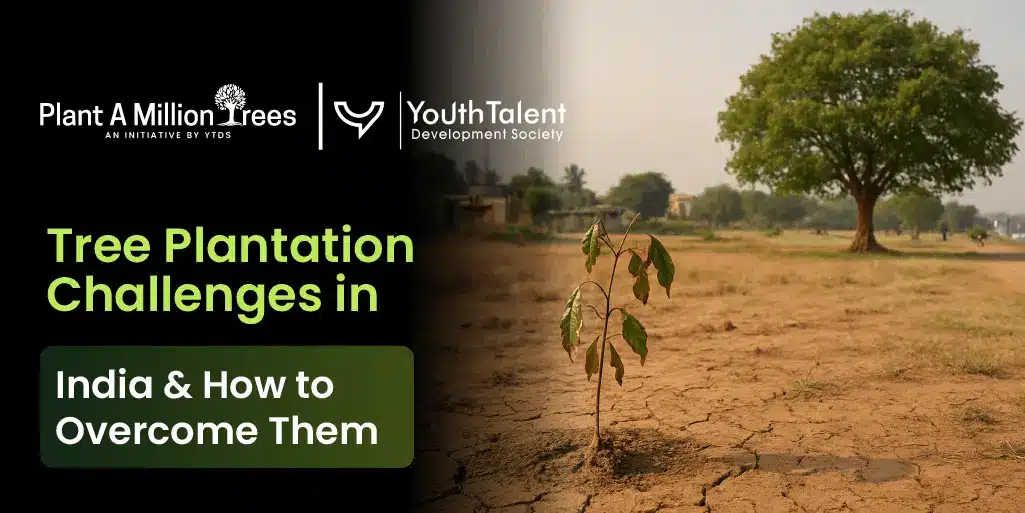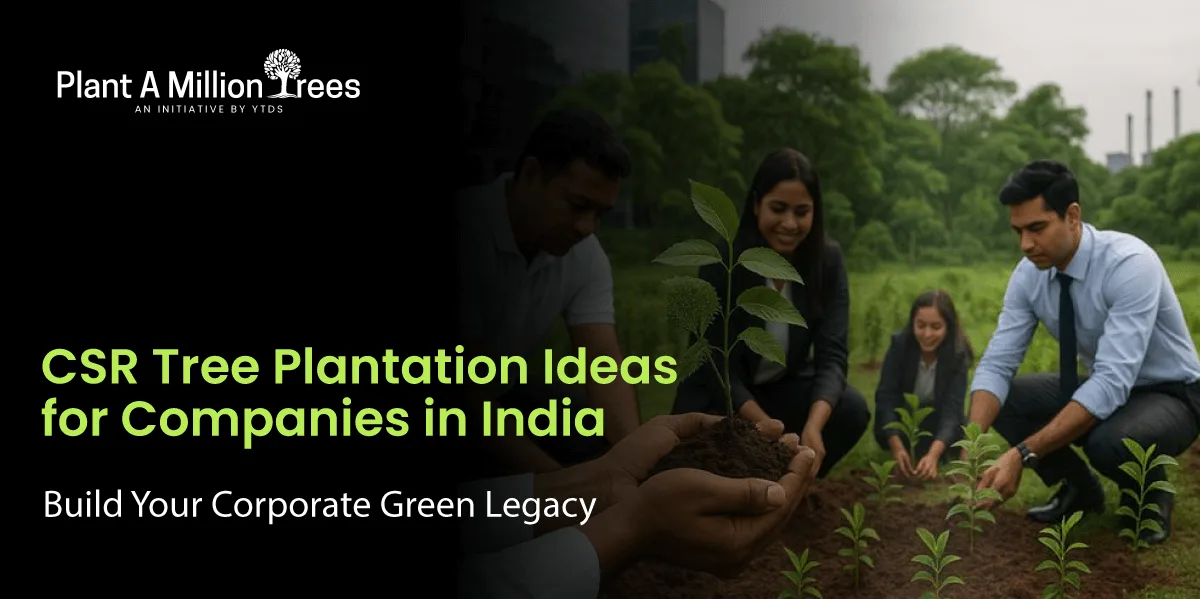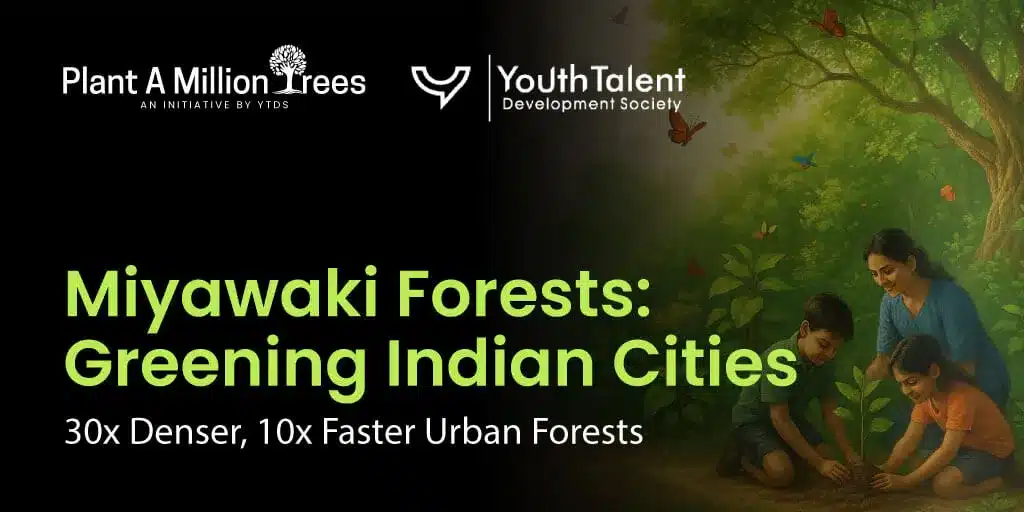India has always realised the potential of trees not only as green cover, but also as living infrastructure that...
In a world where deforestation is destroying the green cover on the planet, two potent strategies are emerging to restore the forests and invigorate the environment to survive; they are afforestation and reforestation.
Nevertheless, though both have the element of planting trees, they are widely divergent in the aspect of purpose, use and the effect they have towards the environment.
This blog will disintegrate the distinction between the rebirth of forests, (afforestation), the revival of extirpated forests (reforestation), the advantages and their utilization in the rescue of forests in India, demonstrating in-layer real-life representation and installation issues.
These concepts are essential to the extent that environmentalists, educators and policy enthusiasts understand them to make a sustainable move.
What Is Afforestation?
Afforestation simply implies planting trees in places where they did not or never existed as forest, even with long time distances in regards. It is the conversion of arid land, eroded landscapes or waste farmlands into green belt, thus bringing in a greater degree of ecological role, with expansion of forests.
Why Afforestation Matters:
- Carbon Sequestration: New trees function as carbon sinks by absorbing CO₂ and mitigating the effect of climate change.
- Land Recovery: Using afforestation, desert and wasteland acres can be reclaimed, the soil kept more fertile, and erosion checked.
- Habitat-Setting: It supports fresh ecosystems along which fauna proliferate on biotic lifeless lands.
- Climate Regulation: The presence of forests helps in regulating weather in an area, lowers temperatures on the surface of the earth and functions like a natural air conditioner.
- Biodiversity Creation: The establishment of forest cover in open terrains will attract pollinators, birds and useful insects, creating biodiversity completely.
Afforestation Examples in India:
- Delhi Ridge: This is a prototype of afforestation; the barren land was again covered with the green belt to fight the urban heat.
- Aravalli Hills (Haryana & Rajasthan): Various afforestation programs have been initiated with the aim of restoring the deforested land and minimizing desertification.
- Western Ghats: Western Ghats have become the home to intensive planting of thousands of native species and their reintroduction; and thus enhancing coffee estate belts with biodiversity.
- Sundarbans (West Bengal): Reforestation after the cyclone is done in view of the brittle mangrove environment.
- Uttarakhand Himalayas: In landslide-prone areas, it will be justified to replenish the natural vegetation covering such as rhododendron tree, oak tree, etc., to ensure slope stabilization and water saving.
Long-term sustainability is pursued by using the proactive approach, i.e., the afforestation is the establishment of forests in places where none had previously existed.
What Is Reforestation?
Reforestation is a process of replenishing the forest in regions where forests were recently cleared up or degraded whether it is made so either by natural factors (wild fires) or human factors (man cutting down the tree and mining). It seeks to recover natural habitat as well as wipe out the initial ecological balance.
Why Reforestation Is Important:
- Forest Regeneration: Reforestation replaces the structure of forests, compositions of forest and its operation.
- Wildlife Recovery: It aids in restoring flora and fauna to their original places, chipping in to the ecological equilibrium.
- Water Conservation: Reforestation stabilizes the water cycles and reduces the runoff and enhances the replenishment of groundwater.
- Revival of soil health: The roots of the trees that are replanted trap soil and keep it intact, stimulate the microbes and retain nutrients.
- Cultural Restoration: Forests are sacred to most of the communities, both economically and culturally; their restoration allows the repossessions of the lost customs and sources of livelihood.
Reforestation Examples in India:
- Himalaya of Uttarakhand: The alien flora is wiped off by nature like diversity and reinstatement of indigenous species such as oak and red rhododendron following occurrence of forest fires and landslides.
- Western Ghats (Kerala & Karnataka): Through re-forestation of dilapidated coffee plantations of indigenous trees, biodiversity is being restored.
- Sundarbans (West Bengal): After the constant occurrence of cyclones, there is mangrove reforestation work in progress to rebuild this delicate coastal forest.
- Satpura and Vindhya Ranges (Madhya Pradesh): The local forest departments are involved in the aerial seeding of native forests with the help of tribals.
- Himachal Pradesh: Under the eco-restoration plans, post-logging and grassing degradation damage is being curbed by re-planting of deodar and kail trees.
Reforestation is in a way restorative i.e. it centers on what has been lost and the central aim is to restore it.
Afforestation vs Reforestation: What Sets Them Apart?
Even though afforestation and reforestation are similar to each other in terms of trees being planted, there lies an important distinction in scope and definition of the two.
Afforestation is tree planting on land that had no existing forest cover previously i.e. barren lands or degraded soils done with the aim of forming a new forest ecosystem.
Conversely, reforestation is concentrated on treating the creation of trees in regions that were previously timbered, but have been destroyed as a result of man-made therapy, fire, or natural calamities.
Afforestation aims at making the previously uncultivated or the arid land green and is usually done as a proactive developmental or environmental course of action.
The purpose of reforestation is however to replace the ecosystem that was lost in restoring biodiversity and ecological balance. To illustrate, afforestation may be done on lands that are mined (in Jharkhand states, they will be turned green again), whereas in other regions as the Arunachal Pradesh districts where the logging has taken place (a reforestation process will have to be taken), it is in places where the original wood has to be replenished.
Ecologically, in both afforestation and reforestation, new and old habitats are formed, respectively, thus ensuring continuity of the native species.
Afforestation is used to increase the green cover in total as opposed to reforestation which helps in achieving the forest goals and in reaching the international climate objectives of India.
Why These Methods Matter for India
India is one of the handful nations that have undertaken to expand the forest cover as part of international climate pledges such as the Paris Protocol. Afforestation as well as reforestation are necessary to:
- CAMPA (Compensatory Afforestation Fund Management and Planning Authority) projects
- National green India mission objectives
- Forest carbon sinks and Carbon credit programs
India: Afforestation is commonly known in India as Khasra.
- Assists in achieving forest goals on carbon deficit trading
- Rebirths open grasslands and deserted farmlands
In India the process of forestation is done by:
- In complement to ecological restoration and development of wildlife corridors
- Covers tribal community rights in the Forest Rights Act
India, when it comes to creating 2.5-3 billion tonnes of additional carbon sink by 2030, targets to succeed by employing such processes as afforestation and reforestation in the center stage.
Hurdles to Planting More Trees

Although the process is supported by policy and funded, forest restoration in India has a series of challenges:
- Land Availability: Most of the lands that are the most appropriate to use have been put into farming or other development with few options to plant new plantations.
- Maintenance and Financing: Very often CAMPA money is not used or not spent properly. Additionally, there is no precision of follow-up services such as watering and fencing, which makes saplings to die.
- Community Resistance: It is also possible that projects neglecting land rights in reforestation areas are opposed by the tribal and forest-dependent groups.
- Long-Term Vision: Most of the projects are aimed at counting the number of trees in the short term instead of ecosystem wellbeing, which ends up in the establishment of mono-plantations that are detrimental to the biodiversity.
- Climate Impacts: Severe weather conditions such as floods, droughts and heatwaves risk the existence of young plantations.
To counter all these, camera should be locally directed, ecologically fair, and community-based.
Be Part of the Green Movement: What You Can Do
You as individual or an organization can make a major contribution to regreening India. Here’s how:
- The launching of Urban Afforestation Drives: Most cities have community-based tree planting in parks, on roadsides and in school grounds. You can enroll in a program of local municipalities or such organizations as Youth Talent Development Society (YTDS).
- NGOs to support Forests: Such NGOs as plantamilliontrees, Give Me Trees, SayTrees, and Grow-Trees.com allow individuals to plant trees in far-flung locations or give donations to forests that have native species.
- Corporate Initiatives and CSR: Under CSR or ESG objectives, the firms can mitigate the emissions through afforestation that supports the green industrial countries and campuses.
- Teach and Give: Participate in eco-clubs, plan a presentation in school, or organize a plantation. A single sapling is a difference.
- Native Trees should be selected: Understanding biodiversity and long-term sustainability are grounded into local species such as Neem, Arjun, Jamun, Peepal and Banyan plantation.
We can begin to live like active green warriors instead of just mere spectators.
Conclusion
The need to reclaim the forest cover on earth cannot be overemphasized. Although afforestation and reforestation might appear synonymous, they are different terms with a defined purpose and effects. Where afforestation comes in to revitalize the dry land, reforestation comes to wash away the wounds of deforestation.
The combination of them would become the backbone of climate resilience, ecological restoration, and sustainable development of India.
“The real time to plant a tree was 20 years before. No Time is the Second-best time.”
This is something we should do today, to leave a cooler planet, touch air and greener future.
FAQs on Afforestation vs Reforestation
What is the contrast between reforestation and afforestation?
Afforestation includes the planting of forest on the hitherto non-forest land whereas reforestation is the replanting of forests in the land portions where the forests were removed or lost.
Is afforestation more effective than reforestation?
Each of them has individual purposes. Afforestation can be used as means to augment the available forest cover on areas that are bare, whereas reforestation can solve seriously degraded ecosystems. Its performance is determined by ecological objectives and action.
Which are some examples of such methods in reality in India?
- Afforestation- greening of Aravalli in Haryana
- Reforestation: Replacement of natural forests of oak trees in Uttarakhand post-fires
Which are the legislations that aid afforestation and reforestation in India?
- Forest Conservation Act (1980)
- National Green India mission
- CAMPA Act (2016)
- The Forest Right Act (2006) provides that tribal people be involved in the conservation of forests
What can the students or citizens do to restore forests?
Participate in plantation campaigns, volunteer in NGOs such as YTDS, start awareness programs in educational institutions and prefer local species in gardens or balconies.




